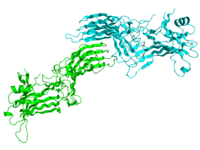
A model for the signal initiation complex between Arrestin-3 and the Src family kinase Fgr.
Sign Up to like & getrecommendations! Published in 2021 at "Journal of molecular biology"
DOI: 10.1016/j.jmb.2021.167400
Abstract: Arrestins regulate a wide range of signaling events, most notably when bound to active G protein-coupled receptors (GPCRs). Among the known effectors recruited by GPCR-bound arrestins are Src family kinases, which regulate cellular growth and… read more here.
Keywords: model signal; fgr; arrestin; src family ... See more keywords

Phosphoproteomic Analysis of Dopamine D2 Receptor Signaling Reveals Interplay of G Protein- and β-Arrestin-Mediated Effects.
Sign Up to like & getrecommendations! Published in 2022 at "Journal of proteome research"
DOI: 10.1021/acs.jproteome.2c00707
Abstract: Leveraging biased signaling of G protein-coupled receptors has been proposed as a promising strategy for the development of drugs with higher specificity. However, the consequences of selectively targeting G protein- or β-arrestin-mediated signaling on cellular… read more here.
Keywords: dopamine receptor; protein arrestin; arrestin mediated; analysis ... See more keywords

Functionally Biased D2R Antagonists: Targeting the β-Arrestin Pathway to Improve Antipsychotic Treatment.
Sign Up to like & getrecommendations! Published in 2018 at "ACS chemical biology"
DOI: 10.1021/acschembio.8b00168
Abstract: Schizophrenia is a severe neuropsychiatric disease that lacks completely effective and safe therapies. As a polygenic disorder, genetic studies have only started to shed light on its complex etiology. To date, the positive symptoms of… read more here.
Keywords: functionally biased; treatment; biased d2r; arrestin ... See more keywords

Allosteric interactions in the parathyroid hormone GPCR–arrestin complex formation
Sign Up to like & getrecommendations! Published in 2020 at "Nature chemical biology"
DOI: 10.1038/s41589-020-0567-0
Abstract: Peptide ligands of class B G-protein-coupled receptors act via a two-step binding process, but the essential mechanisms that link their extracellular binding to intracellular receptor–arrestin interactions are not fully understood. Using NMR, crosslinking coupled to… read more here.
Keywords: pth; arrestin complex; parathyroid hormone; arrestin ... See more keywords

Residency time of agonists does not affect the stability of GPCR–arrestin complexes
Sign Up to like & getrecommendations! Published in 2022 at "British Journal of Pharmacology"
DOI: 10.1111/bph.15846
Abstract: The interaction of arrestins with G‐protein coupled receptors (GPCRs) desensitizes agonist‐dependent receptor responses and often leads to receptor internalization. GPCRs that internalize without arrestin have been classified as “class A” GPCRs whereas “class B” GPCRs… read more here.
Keywords: agonists affect; residency time; affect stability; arrestin ... See more keywords

Noncanonical scaffolding of Gαi and β-arrestin by G protein–coupled receptors
Sign Up to like & getrecommendations! Published in 2021 at "Science"
DOI: 10.1126/science.aay1833
Abstract: Another way for GPCRs to signal G protein–coupled receptors (GPCRs) normally transmit signals by coupling to heterotrimeric guanine nucleotide–binding proteins (G proteins) or by binding β-arrestin proteins. Smith et al. provide evidence for another mechanism,… read more here.
Keywords: protein; arrestin complexes; arrestin; protein coupled ... See more keywords

Biased agonists of the chemokine receptor CXCR3 differentially signal through Gαi:β-arrestin complexes
Sign Up to like & getrecommendations! Published in 2022 at "Science Signaling"
DOI: 10.1126/scisignal.abg5203
Abstract: G protein–coupled receptors (GPCRs) are the largest family of cell surface receptors and signal through the proximal effectors, G proteins and β-arrestins, to influence nearly every biological process. The G protein and β-arrestin signaling pathways… read more here.
Keywords: arrestin complex; arrestin complexes; arrestin; protein ... See more keywords

Beta-arrestin-biased agonism promotes TRPC6-mediated calcium influx in human podocytes
Sign Up to like & getrecommendations! Published in 2023 at "Physiology"
DOI: 10.1152/physiol.2023.38.s1.5731762
Abstract: Background: Angiotensin Receptor blockers (ARBs) are the first-line treatment for hypertension and other chronic kidney diseases and act by inhibiting signaling through the angiotensin 1 receptor (AT1R). AT1R activation initiates signaling through G protein-coupled receptor… read more here.
Keywords: trv; trpc6 mediated; physiology; arrestin ... See more keywords

Beta-arrestin-biased protease-activated receptor-2 antagonists preferentially limit allergen-induced responses in vivo.
Sign Up to like & getrecommendations! Published in 2023 at "Physiology"
DOI: 10.1152/physiol.2023.38.s1.5734466
Abstract: Biased signaling in G protein-coupled receptors (GPCRs) has emerged as a target for drug development. Protease-activated receptor-2 (PAR2) is a GPCR present in the airway epithelium with biased signaling that has been shown to trigger… read more here.
Keywords: allergen induced; protease activated; physiology; arrestin ... See more keywords

ARRB2 (β-Arrestin-2) Deficiency Alters Fluid Homeostasis and Blood Pressure Regulation
Sign Up to like & getrecommendations! Published in 2022 at "Hypertension"
DOI: 10.1161/hypertensionaha.122.19863
Abstract: Background: GPCRs (G protein–coupled receptors) are implicated in blood pressure (BP) and fluid intake regulation. There is a developing concept that these effects are mediated by both canonical G protein signaling and noncanonical β-arrestin mediated… read more here.
Keywords: arrb2; arrb2 knockout; arrestin; mice ... See more keywords

Tripterygium glycoside protects diabetic kidney disease mouse serum-induced podocyte injury by upregulating autophagy and downregulating β-arrestin-1.
Sign Up to like & getrecommendations! Published in 2019 at "Histology and histopathology"
DOI: 10.14670/hh-18-097
Abstract: BACKGROUND Diabetic kidney disease (DKD), one of the most common causes of end-stage renal disease(ESRD), remains prevalent in many populations. Podocyte loss and apoptosis play a crucial role in the progression of DKD. Tripterygium glycoside… read more here.
Keywords: arrestin; serum; tripterygium glycoside; tripterygium ... See more keywords